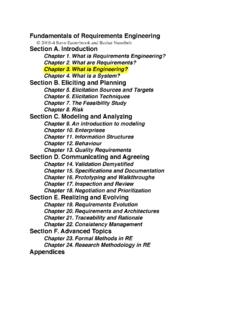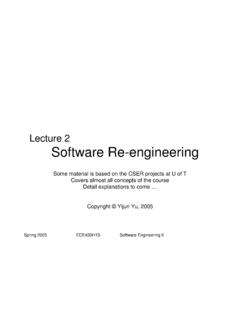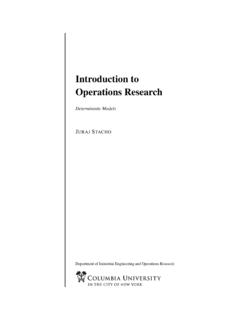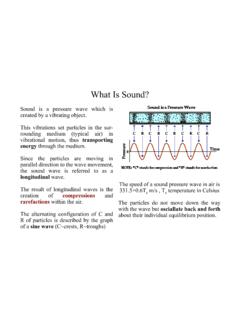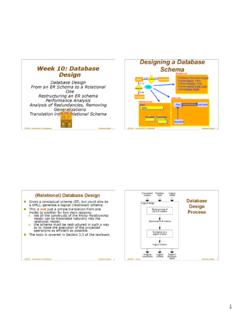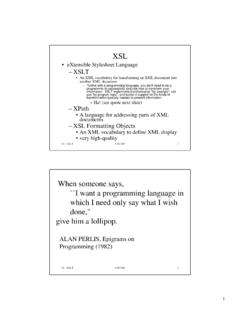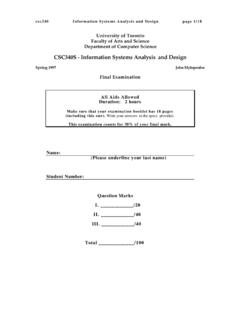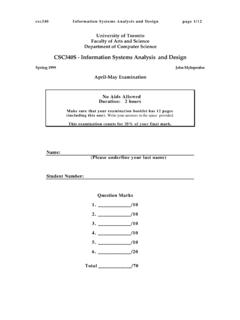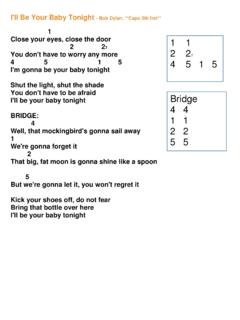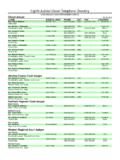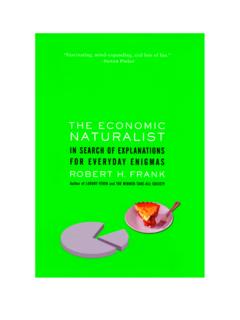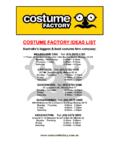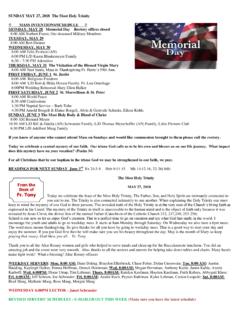Transcription of XSLT: Using XML - University of Toronto
1 1 xslt : Using XML to transform other XML filesIntroduction to databasesCSC343 Fall 2011 Ryan JohnsonThanks to Manos Papagelis, John Mylopoulos, Arnold Rosenbloomand Renee Miller for material in these slidesWhat is xslt ? An XML based style sheet language for XML documents Tells web browser how to display data Similar to CSS for HTML, but with absolute control over input Achieves similar results to XQuery Pro: supported by all non ancient web browsers Con: XML syntax is [really] verbose2 xslt processing model The xslt processing model involves.
2 One (or more) XML source documents one (or more) xslt style sheet modules the xslt template processing engine one (or more) result documents xslt is most often used to convert data between different XML schemas to convert XML data into web pages (HTML)3 xslt vs XQUERY xslt capabilities overlap with XQuery same data model, type system, function library both include XPath as a sublanguage Rooted in different traditions and communities xslt : primarily conceived as a stylesheet language XQuery: primarily conceived as a database query language When to use: xslt : stronger in its handling of narrative documents with more flexible structure XQuery: stronger in its data handling ( , when performing relational joins)42 Example 1: Transform.
3 XML to HTML<?xml version=" " encoding="ISO 8859 1"?> <catalog> <cd> <title>Empire Burlesque</title> <artist>Bob Dylan</artist> <country>USA</country> <company>Columbia</company> <price> </price> <year>1985</year> </cd>..<cd> <title>Unchain my heart</title> <artist>Joe Cocker</artist> <country>USA</country> <company>EMI</company> <price> </price> <year>1987</year> </cd> </catalog>5 The XML DocumentExample 1: Transform. XML to HTML<?xml version=" " encoding="ISO 8859 1"?> <xsl:stylesheetversion=" " xmlns:xsl=" "> <xsl:templatematch="/"> <html> <body> <h2>My CD Collection</h2> <table border="1"> <tr bgcolor="#9acd32 > <th>Title</th> <th>Artist</th> </tr> <xsl:for each select="catalog/cd"> <tr> <td> <xsl:value of select="title"/> </td> <td> <xsl:value of select="artist"/> </td> </tr> </xsl:for each> </table> </body> </html> </xsl:template> </xsl:stylesheet>6 The xslt for the XMLE xample 1: Transform.
4 XML to HTMLMy CD Collection7 TitleArtistEmpire BurlesqueBob my heartJoe CockerThe HTML Result DocumentExample 2: Transform. XML to XML<?xmlversion=" "?> <persons> <personusername="JS1"> <name>John</name> <family name>Smith</family name> </person> <personusername="MI1"> <name>Morka</name> <family name>Ismincius</family name> </person> </persons>8 The XML Document3 Example 2: Transform. XML to XML<?xmlversion=" " encoding="UTF 8"?> <xsl:stylesheetxmlns:xsl= " "> <xsl:outputmethod="xml" indent="yes"/> <xsl:templatematch="/persons"> <root> <xsl:apply templatesselect="person"/> </root> </xsl:template> <xsl:templatematch="person"> <nameusername="{@username}"> <xsl:value ofselect="name" /> </name> </xsl:template> </xsl:stylesheet>9 The xslt for the XMLE xample 2: Transform.
5 XML to XML<?xmlversion=" " encoding="UTF 8"?> <root> <nameusername="JS1">John</name> <nameusername="MI1">Morka</name> </root>10 The HTML Result DocumentXSLT in a nutshell All XSL commands are xml (xsl:namespace) Everything works by templates Output generated by instantiating templates Templates can call other templates (recursion allowed) No output unless some template matches document root Overloading rules for resolving 2+ matching templates Builds on material we already know XPath used to select nodes for various uses Embedded expressions use {} syntax from XQuery11 Control flow in XSL <xsl:for eachselect=.
6 >..</xsl:for each> Used to select every XML element of a specified node set Instantiate the template once for each item Inside the template, context node (.) refers to current item <xsl:iftest= .. >..</xsl:if> Used to put a conditional test against the content of the XML file Instantiate the template inside if the condition is true No else (use a second xsl:ifor xsl:chooseinstead) <xsl:choose>..</xsl:choose> used along with <xsl:when> and <xsl:otherwise> to express multiple conditional tests <xsl:whentest= .. >..</xsl:when> (same usage as xsl:if) <xsl:otherwise>.
7 </xsl:otherwise> (no match template) Instantiate only one template (first match wins)124 Sorting elements Elements can be sorted inside for each loops <xsl:sortselect= .. order= .. /> select should identify the element to sort on order can be ascending or descending Example:<xsl:for eachselect= //book > <xsl:sortselect= author/surname /> <xsl:sortselect= author/given name />..</xsl:for each>13 Declaring variables <xsl:variable name= .. select= .. /> Store the result of an XPath query in a variable <xsl:variable name= .. >..</xsl:variable> Instantiate a template and store its result in a variable Notes Default value (if none specified) is an empty string Cannot be overwritten or updated once set Sometimes valid as input to templates (more later)14 Declaring templates Idea: A template contains rules to apply when a specified node is matched.
8 Results are inserted into the output <xsl:templatematch= .. mode= .. > Template instantiated for every element satisfying the match s XPath expression Optional mode attribute allows to select from 2+ templates <xsl:templatename= .. > Template instantiated explicitly OK to namea matchtemplate15 Applying vs. calling templates <xsl:apply templatesselect= .. mode= .. /> Applies a template to the current element or to the its child nodes Format a node (default: .) Using best matching template Complicated priority rules, but more specific and declared later templates usually chosen=> When in doubt disambiguate Using optional mode attribute <xsl:call templatename=.
9 /> Instantiate the named template WARNING: context node unchanged by call!=> Call a template which uses . ==> possible infinite loop <xsl:parameter> and <xsl:with param> Templates can declare xsl:parameter(acts just like xsl:variable)=> Same effect if template is called normally Template call can have xsl:with paramchild elements=> Overrides value which xsl:parameterwould have assigned165 Applying templates to variables Only select type variables have XML content Otherwise, contents treated as text Limitation of both xslt and (fixed by EXSLT, next) Example:<xsl:variable name= foo select= //foo /> <xsl:variable name= bar > <xsl.
10 Apply templates select= $foo > </xsl:variable> <xsl:variable name= baz > <xsl:apply templates select= $bar > </xsl:variable>17$foo stores XML$bar stores text! EXSLT The EXSLT spec addresses weaknesses of xslt Several modules each with its own namespace Supported by modern xslt processors (IE9, FF3+, etc.) Have to ask for it by adding namespaces Especially handy modules: xmlns:exsl= => Provides exsl:node-set, a function to turn text into XML xmlns:str= => Provides str:split, which works just like python s split()18 Outputting things <xsl:text>.
